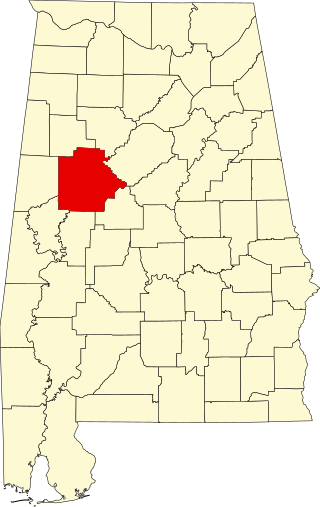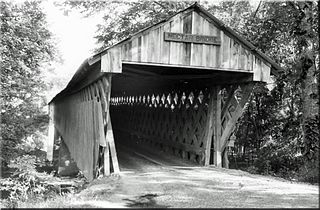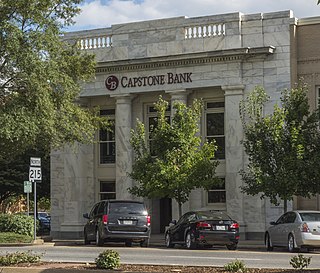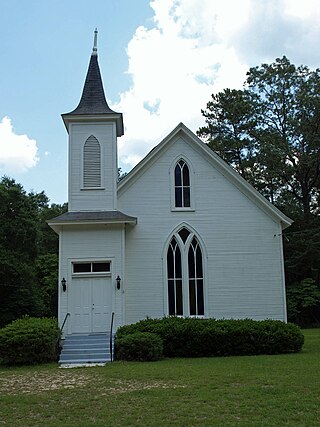
Tuscaloosa is a city in and the seat of Tuscaloosa County in west-central Alabama, United States, on the Black Warrior River where the Gulf Coastal and Piedmont plains meet. Alabama's fifth-most populous city. The population was 99,600 at the 2020 census, and was estimated to be 110,602 in 2022. It was known as Tuskaloosa until the early 20th century. It is also known as "the Druid City" because of the numerous water oaks planted in its downtown streets since the 1840s.

This is a list of the National Register of Historic Places listings in Tuscaloosa County, Alabama.

The Clarkson–Legg Covered Bridge, more simply known as Clarkson Covered Bridge, is a county-owned wooden covered bridge that spans Crooked Creek in Cullman County, Alabama, United States. It is located at Clarkson Covered Bridge Park on County Road 1043 off U.S. Route 278 near the community of Bethel, about 8 mi (13 km) west of Cullman.

The Nectar Covered Bridge was a wood and metal combination style covered bridge which spanned the Locust Fork of the Black Warrior River in Blount County, Alabama, United States. It was located on Nectar Bridge Road off State Route 160, just east of the town of Nectar, about 14 miles northwest of Oneonta. Nectar Covered Bridge was at one time the seventh-longest covered bridge in the country. The bridge remained open to single lane motor traffic from its construction until it was burned by vandals on June 13, 1993.

Altwood is a historic plantation house located near Faunsdale, Alabama. It was built in 1836 by Richard H. Adams and began as a log dogtrot house. It was then expanded until it came to superficially resemble a Tidewater-type cottage. Brought to the early Alabama frontier by settlers from the Tidewater and Piedmont regions of Virginia, this vernacular house-type is usually a story-and-a-half in height, displays strict symmetry, and is characterized by prominent end chimneys flanking a steeply pitched longitudinal gable roof that is often pierced by dormer windows.

The Furman Historic District is a historic district in the community of Furman, Alabama, United States. It was placed on the National Register of Historic Places on May 13, 1999. The boundaries are roughly Old Snow Hill Road, Wilcox County Road 59, Burson Road, and AL 21. It contains 1,030 acres (420 ha), 73 buildings, and 14 structures.

The Goode–Hall House, also commonly known as Saunders Hall, is a historic plantation house in the Tennessee River Valley near Town Creek, Alabama. It was added to the National Register of Historic Places on October 1, 1974, due to its architectural significance.

The First Presbyterian Church is a historic Greek Revival church building in Eutaw, Alabama. The two-story frame structure was built for the local Presbyterian congregation in 1851 by David R. Anthony. Anthony was a local contractor who constructed many of Eutaw's antebellum buildings. The congregation was organized by the Tuscaloosa Presbytery in 1824 as the Mesopotamia Presbyterian Church. John H. Gray served as the first minister from 1826 until 1836. The church was added to the National Register of Historic Places on December 16, 1974, due to its architectural and historical significance. The church is a member of the Presbyterian Church in America.

The Greene County Courthouse Square District is a historic district in Eutaw, Alabama. It is centered on the old Old Greene County Courthouse and extends outward along U.S. Route 11 and Alabama State Route 7. It features examples of Greek Revival and commercial architecture. The district was added to the National Register of Historic Places on December 31, 1979.

Fort Strother was a stockade fort at Ten Islands in the Mississippi Territory, in what is today St. Clair County, Alabama. It was located on a bluff of the Coosa River, near the modern Neely Henry Dam in Ragland, Alabama. The fort was built by General Andrew Jackson and several thousand militiamen in November 1813, during the Creek War and was named for Captain John Strother, Jackson's chief cartographer.
Seven segments of the historic Natchez Trace are listed on the National Register of Historic Places (NRHP). Also there are additional NRHP-listed structures and other sites along the Natchez Trace, which served the travelers of the trace and survive from the era of its active use.

The Bishop Manor Estate is a historic estate near St. Elmo in rural Mobile County, Alabama, United States. Contributing to the National Register of Historic Places listing are a main house, a five bay garage, a guest house, two outbuildings, a swimming pool and a pavilion. Spread over a formally landscaped 7 acres (2.8 ha), the Mediterranean Revival style estate was built in 1925 by Steven Bishop. It was placed on the National Register of Historic Places on February 14, 1985.

The Davis-Oak Grove District is a historic district near Mauvilla in rural Mobile County, Alabama, United States. It is on the western side of Oak Grove Road, north of the intersection with Kali Oka Road. The district covers 12.2 acres (0.049 km2) and contains 16 contributing properties. It was placed on the National Register of Historic Places on May 3, 1988.

The Jemison–Van de Graaff Mansion, also known as the Jemison–Van de Graaf–Burchfield House, is a historic house in Tuscaloosa, Alabama, United States. The structure remained a private residence until 1955, when it served first as a library, then publishing house offices, and lastly as a historic house museum. The mansion was added to the National Register of Historic Places on April 19, 1972, due to its architectural significance.

The Whatley Historic District is a historic district in the community of Whatley, Alabama. Whatley was founded with the establishment of a railroad depot in 1887, along the then-newly constructed railroad between Mobile and Selma. It was incorporated as a town in 1901. The historic district features examples of Craftsman, Queen Anne, and regional vernacular architecture. Spread over 45 acres (18 ha) with 17 contributing buildings and one object, it is roughly bounded by the Whatley Road from Grove Hill to the railroad tracks. It is a part of the Clarke County Multiple Property Submission and was placed on the National Register of Historic Places on April 30, 1998.

Suggsville is an unincorporated community in Clarke County, Alabama.

The City National Bank is an historic building in Tuscaloosa, Alabama. It was designed in the Classical Revival Style by William Leslie Welton and was built in 1922. It was listed on the National Register of Historic Places in 1985.

Latham United Methodist Church is a historic church building on the east side of Highway 59 in Baldwin County. It was built in 1906 and added to the National Register of Historic Places in 1988. This church is one of the last remaining buildings that was located in Latham, Alabama.

St. Patrick's Catholic Church is a historic Roman Catholic church on the east side of Hwy. 90 in Loxley, Alabama. It was built in 1924 and added to the National Register of Historic Places in 1988. The Loxley Public Library currently occupies the building.
The C.S.S. Huntsville and C.S.S. Tuscaloosa Historic and Archaeological District is a shipwreck site in the Mobile River near Mobile, Alabama. The Huntsville and the Tuscaloosa were ironclad warships built in 1863 at the Confederate Naval Works in Selma, Alabama. They were fitted out in Mobile, but due to an unusual hull design, were relegated to being used as floating batteries. The ships were scuttled by retreating Confederates after the capture of Mobile in April 1865 and used as blockships.





















